12 No code automation tools You Should Know
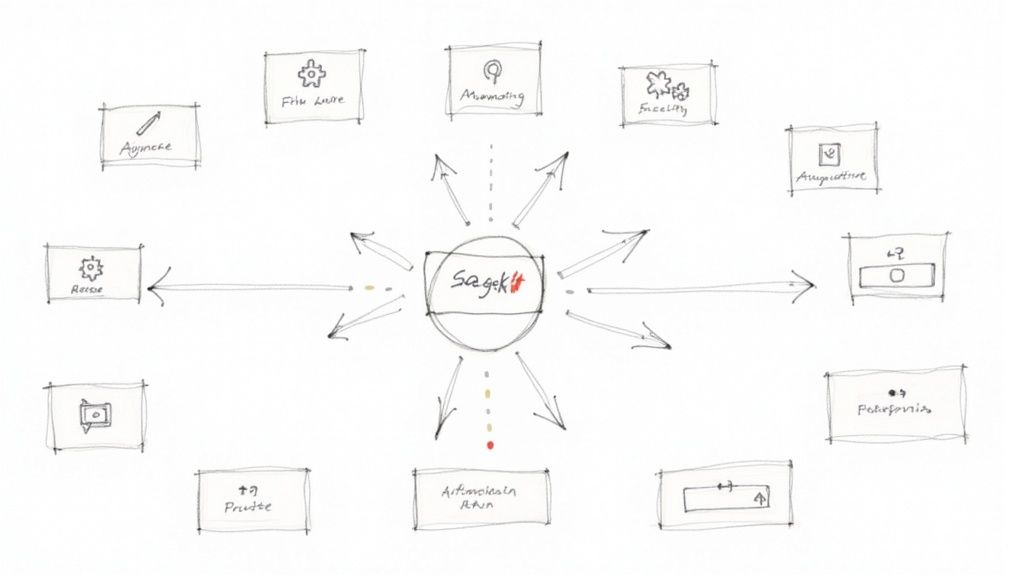
Drowning in repetitive tasks is a common bottleneck for growth, whether you’re a solopreneur managing spreadsheets or a startup team juggling leads. The solution isn’t necessarily hiring more people or learning to code; it’s about working smarter. This is where no-code automation tools become essential, acting as digital assistants that connect your apps and handle routine workflows automatically. From syncing customer data between your CRM and email marketing platform to generating daily reports, these tools free up your time for more strategic work.
If you’re just getting started and need a clear explanation of the core concepts, this practical guide on what no-code automation is all about is an excellent resource.
This comprehensive listicle is designed to help you navigate the crowded market and find the perfect platform for your specific needs. We’ll move beyond generic feature lists to provide a detailed comparison of the top no-code automation tools available today. For each tool, you’ll find a breakdown of its ideal user, key features, pricing structure, and practical limitations. With direct links and screenshots, you’ll gain the insights needed to select a tool that can streamline your operations, enhance productivity, and give you back your most valuable asset: time.
1. Sagekit
Sagekit positions itself as a premier AI-first choice among no code automation tools, engineered to convert simple, plain-English instructions into fully functional, multi-step workflows. Its core innovation lies in its chat-based interface where users describe a task, such as “Summarize my unread emails from yesterday and send the key points to my #updates Slack channel,” and Sagekit visually assembles the automation in real-time. This natural language approach removes the traditional need to manually configure triggers, logic blocks, and actions, making automation accessible to anyone.
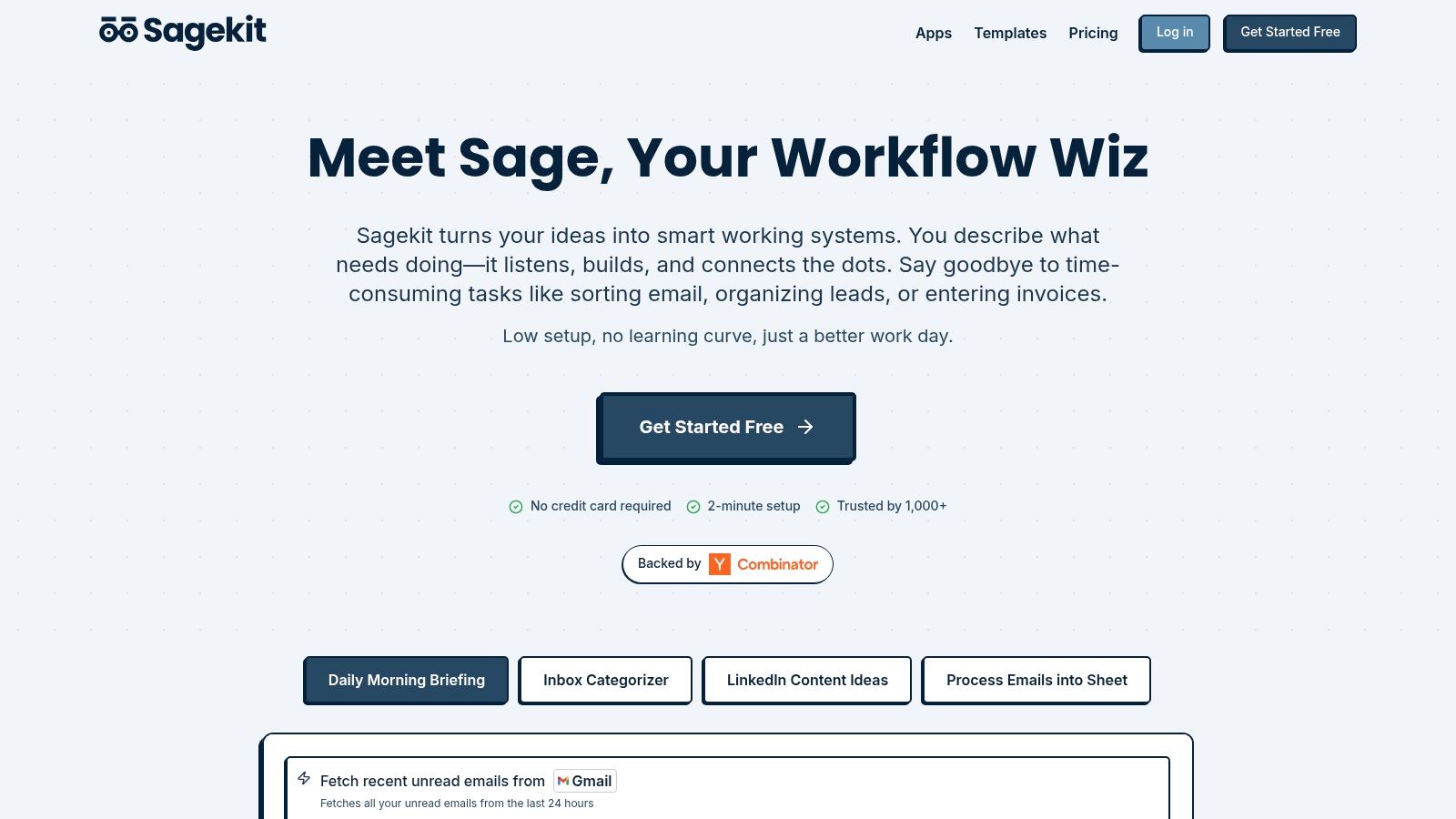
The platform integrates deeply with essential business applications like Gmail, Google Sheets, Slack, Notion, and Airtable, combining them with AI models (ChatGPT/Gemini) and data enrichment tools like web scraping and search. This powerful combination enables sophisticated use cases, from automating morning briefings with relevant news to parsing inbound leads directly into a CRM or spreadsheet.
Key Features & User Experience
Sagekit is designed for speed and simplicity. The onboarding process is remarkably fast, taking just a couple of minutes with no credit card required for the free tier. Users benefit from one-click logins that bypass the need for complex API key management, a common friction point in other tools.
- Natural Language to Workflow: The primary differentiator. Simply describe what you need, and the platform builds it.
- AI-Powered Steps: Go beyond simple data transfer by incorporating AI for summarizing text, extracting information, and generating content.
- Team Collaboration: The Growth plan ($69/mo) introduces shared workflows, unified billing for up to 10 users, and a dedicated Slack channel for support, making it ideal for team adoption.
- Pricing: A generous Free tier allows for unlimited workflow creation. Paid plans include Pro ($19/mo) and Growth ($69/mo), scaling based on usage credits and team features.
Practical Application & Limitations
For professionals looking to reclaim time from repetitive tasks, Sagekit offers a direct path. Practical scenarios include creating daily digests of starred emails, capturing lead data from web forms, or extracting key figures from invoices. However, while the AI-driven data extraction is potent, users should be mindful that mission-critical data might require a final human review. Additionally, very high-volume users may find the credit limits on standard plans restrictive, necessitating a move to an enterprise solution.
Website: https://sagekit.com
2. Zapier
Zapier is arguably the most recognizable name among no code automation tools, functioning as a powerful digital intermediary that connects over 6,000 web applications. It allows users to create automated workflows, called “Zaps,” that trigger actions in one app based on events in another. Its immense app ecosystem is its primary strength, making it incredibly likely that the software you already use can be connected and automated without writing a single line of code.

The platform is designed for accessibility, with a straightforward user interface that guides you through creating simple or complex multi-step Zaps. You can use features like Filters to run workflows only when specific conditions are met, or Paths to introduce conditional branching logic. For those just exploring, a guide to Zapier’s free plan can be an excellent starting point to understand its capabilities without immediate investment.
Key Details & Use Cases
- Best For: Individuals and teams needing to connect a wide variety of mainstream and niche SaaS applications quickly.
- Pricing: Starts with a free forever plan with limited tasks. Paid plans begin at $19.99/month (billed annually) and scale based on task volume and access to premium features.
- Unique Feature: The sheer size of its app directory is unmatched, offering pre-built connections for almost any conceivable workflow.
- Limitation: Costs can escalate quickly as your task usage increases, and advanced team collaboration features are reserved for higher-tier plans.
For a deeper dive into how it compares with other tools, you can explore various Zapier alternatives to find the best fit for your specific needs.
Website: https://zapier.com
3. Make (formerly Integromat)
Make, previously known as Integromat, distinguishes itself among no code automation tools with its highly visual and powerful drag-and-drop scenario builder. It allows users to create intricate, multi-step workflows with a level of granular control that appeals to those building complex automations. Its canvas-based interface lets you see exactly how data flows between applications, making it easier to visualize and debug branching logic, filters, and routers.
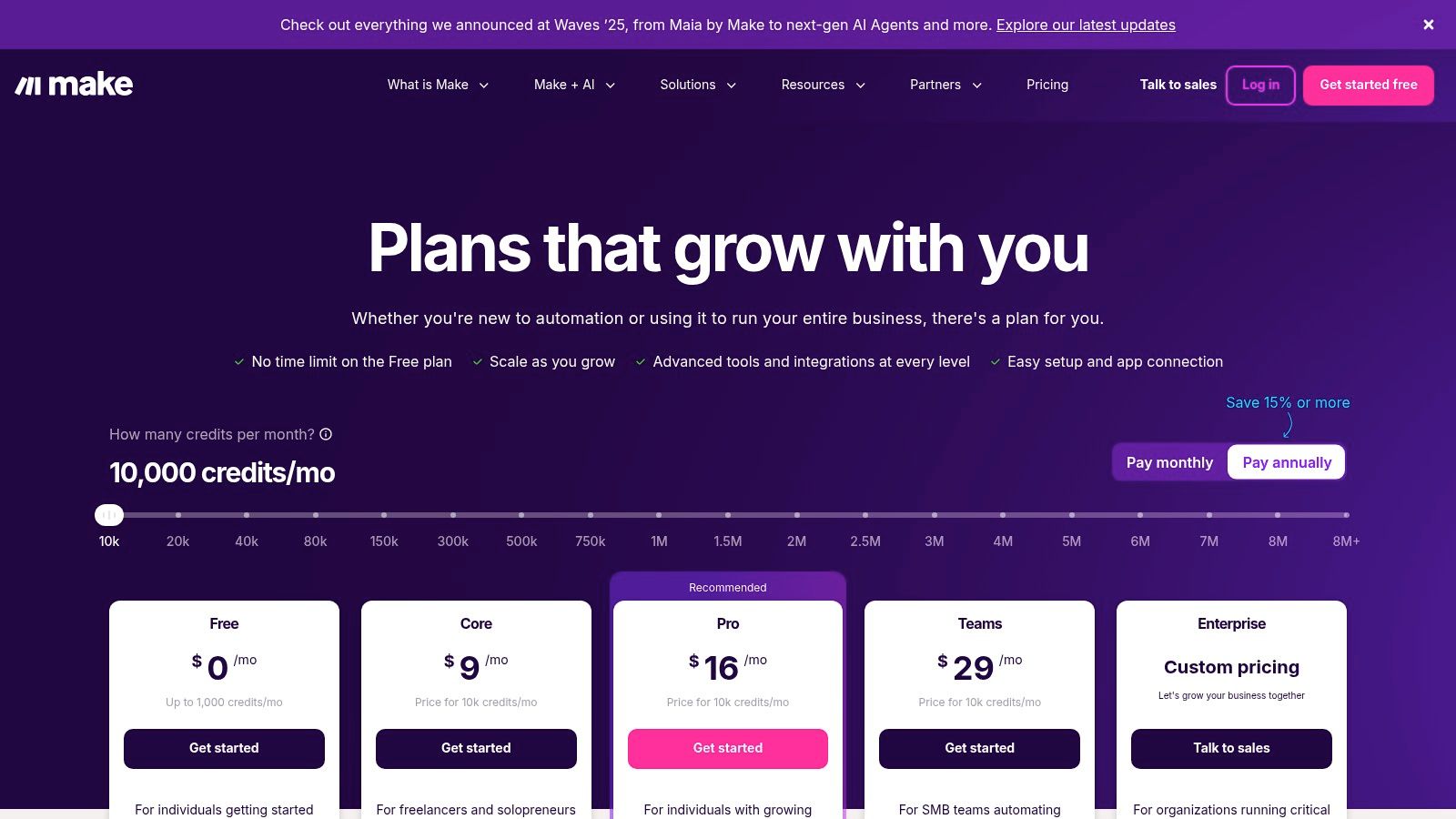
The platform connects over 2,000 apps and is particularly strong for tasks requiring precise scheduling and data manipulation. Its credit-based usage model is often more cost-effective for high-volume operations compared to task-based alternatives. This approach makes it a favorite for developers and power users who need advanced functionality without the associated high costs. For those comparing it to other platforms, exploring a detailed breakdown of Sagekit vs. Make can provide further clarity on which tool best suits your needs.
Key Details & Use Cases
- Best For: Technologically savvy users and businesses that require complex, multi-path workflows and fine-tuned control over data processing.
- Pricing: Offers a free forever plan with 1,000 ops/month. Paid plans start at $9/month (billed annually), scaling based on operations and features.
- Unique Feature: The visual workflow editor provides an intuitive, flowchart-like canvas that makes designing and understanding complex, non-linear automations remarkably clear.
- Limitation: The “operations” credit system can be confusing for new users to calculate, and the learning curve is steeper than simpler, linear automation tools.
Website: https://www.make.com/pricing
4. n8n
n8n stands out in the world of no code automation tools by offering a powerful, open-source, and self-hostable alternative. This “fair-code” model gives users complete control over their data and workflows, which can be run either on their own infrastructure for free or via a managed cloud service. It’s particularly attractive for those with privacy concerns or developers who want the flexibility to extend the platform’s capabilities with custom code.

The platform utilizes a visual, node-based editor where users connect different applications and services (nodes) to build complex automations. Unlike many competitors that charge per task or step, n8n’s pricing model is based on workflow executions, allowing for an unlimited number of steps within a single workflow. This encourages the creation of sophisticated, multi-layered automations without the fear of rapidly escalating costs, making it a highly scalable solution for growing businesses.
Key Details & Use Cases
- Best For: Tech-savvy users, developers, and businesses that prioritize data privacy, cost-effectiveness at scale, and the ability to customize or self-host their automation platform.
- Pricing: A free, self-hosted Community plan is available. Paid cloud plans start at €20/month, scaling based on the number of workflow executions.
- Unique Feature: Its source-available, self-hosting option provides unparalleled control and privacy, keeping all workflow data within your own environment.
- Limitation: The self-hosted version requires some technical or DevOps knowledge to set up and maintain, which can be a barrier for non-technical users.
Website: https://n8n.io/pricing
5. IFTTT
IFTTT, which stands for “If This Then That,” is one of the most accessible no code automation tools, built around simple conditional statements called “Applets.” It connects over 900 services, with a strong focus on consumer apps, smart home devices, and personal productivity. Its intuitive, straightforward approach makes it an ideal entry point for individuals looking to automate their digital lives, from synchronizing social media posts to controlling smart lights with voice commands.
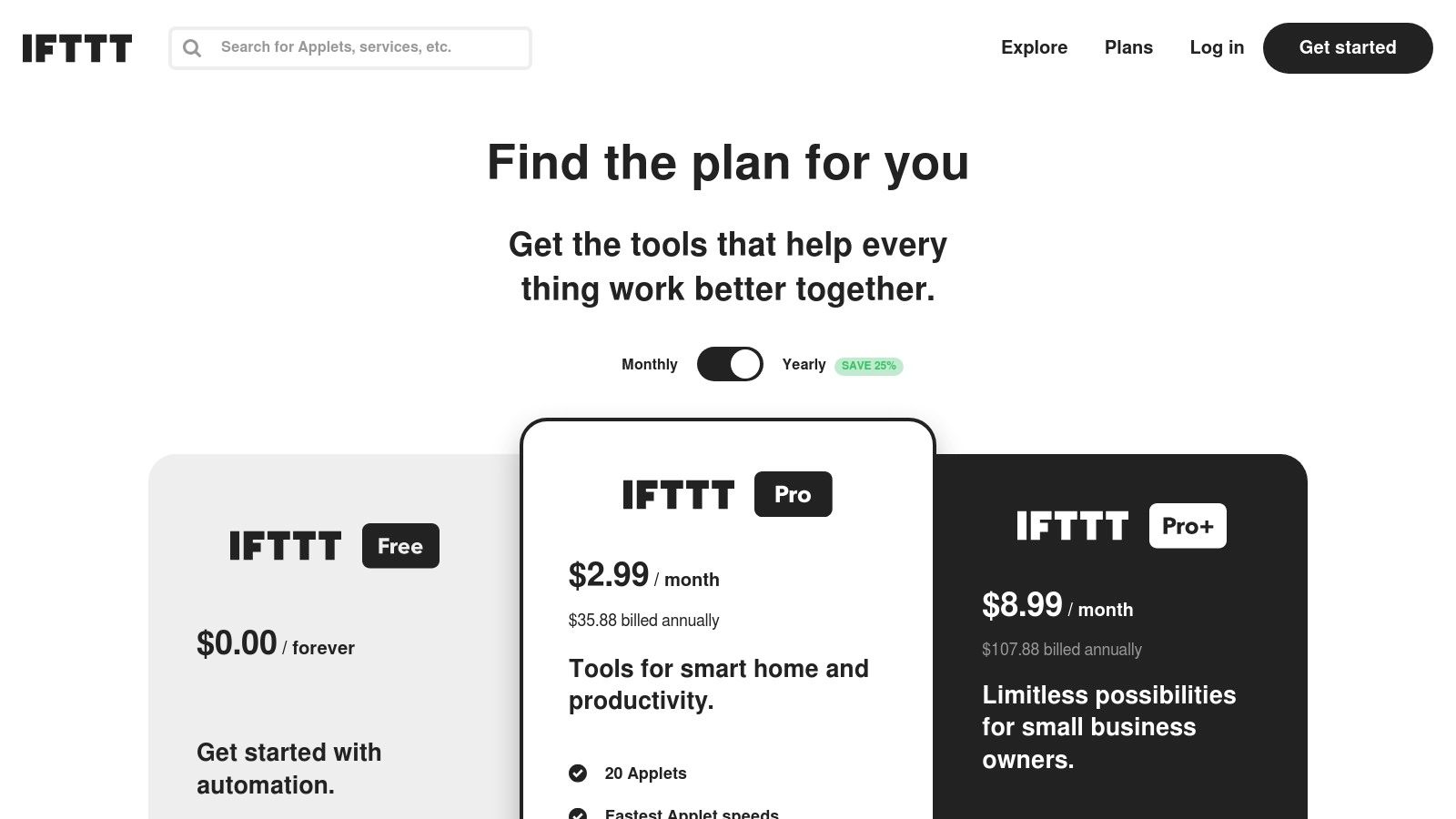
The platform shines with its massive library of pre-built Applets and user-friendly mobile apps, allowing users to get started in minutes. While the free plan is generous, paid tiers unlock more powerful capabilities. The Pro+ plan, for instance, introduces advanced features like queries to pull specific data, filter code to add custom logic with JavaScript, and the ability to connect multiple accounts from a single service, moving beyond basic trigger-action workflows.
Key Details & Use Cases
- Best For: Individuals automating personal tasks, smart home enthusiasts, and small businesses needing simple, set-and-forget workflows.
- Pricing: Offers a free plan for 2 Applets. Paid plans start at $2.50/month (billed annually) for more Applets and multi-action capabilities.
- Unique Feature: Its consumer-centric focus and strong integration with IoT (Internet of Things) devices set it apart from more business-oriented platforms.
- Limitation: It is less suited for complex, multi-step business process automation and can have rate limits on certain services that restrict high-volume use.
Website: https://ifttt.com/plans
6. Microsoft Power Automate
Microsoft Power Automate is a robust platform that bridges the gap between simple API-based automation and complex Robotic Process Automation (RPA). As part of the wider Microsoft Power Platform, its core strength lies in its profound integration with the Microsoft 365, Dynamics 365, and Azure ecosystems. This makes it a natural choice for organizations already invested in Microsoft’s software stack, allowing users to automate everything from simple email notifications in Outlook to sophisticated data processes in SharePoint and Dynamics.
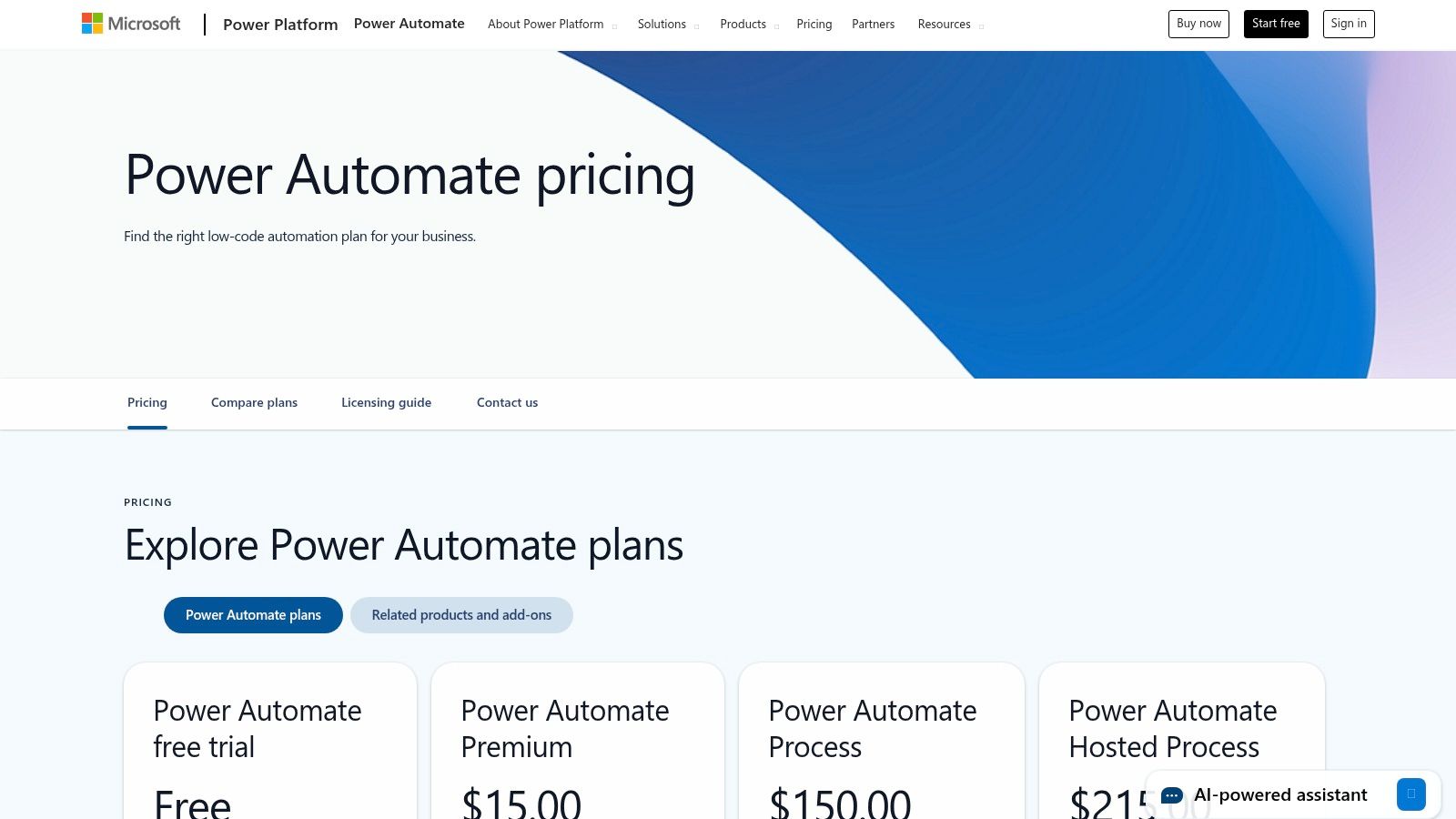
The platform offers both cloud flows for connecting modern APIs and desktop flows for automating legacy applications through RPA. It is built with enterprise needs in mind, providing strong governance, compliance, and security controls that are often critical for larger businesses. Features like Process Mining and Task Mining help organizations identify and prioritize automation opportunities, making it a comprehensive tool for digital transformation and one of the most powerful no code automation tools for enterprise environments.
Key Details & Use Cases
- Best For: Enterprises and teams deeply embedded in the Microsoft ecosystem seeking a unified platform for both cloud and desktop automation with strong governance.
- Pricing: Licensing can be complex. Plans include a limited free version within M365, per-user plans starting at $15/user/month, and various per-flow or per-bot plans.
- Unique Feature: The combination of cloud-based API automation (cloud flows) and RPA (desktop flows) within a single, governable platform.
- Limitation: The pricing structure can be confusing to navigate, and achieving full functionality sometimes requires purchasing multiple add-ons.
For those looking to evaluate other options with different strengths, exploring a list of Power Automate alternatives can provide valuable insights.
Website: https://www.microsoft.com/power-platform/products/power-automate/pricing
7. Workato
Workato is an enterprise-grade automation platform that bridges the gap between powerful integration capabilities and a no code user experience. It’s designed for organizations that require robust governance, security, and scalability for their automations. Workato excels in handling complex business processes, from internal HR and finance workflows to customer-facing product integrations, all managed within a collaborative, low-code/no-code environment.
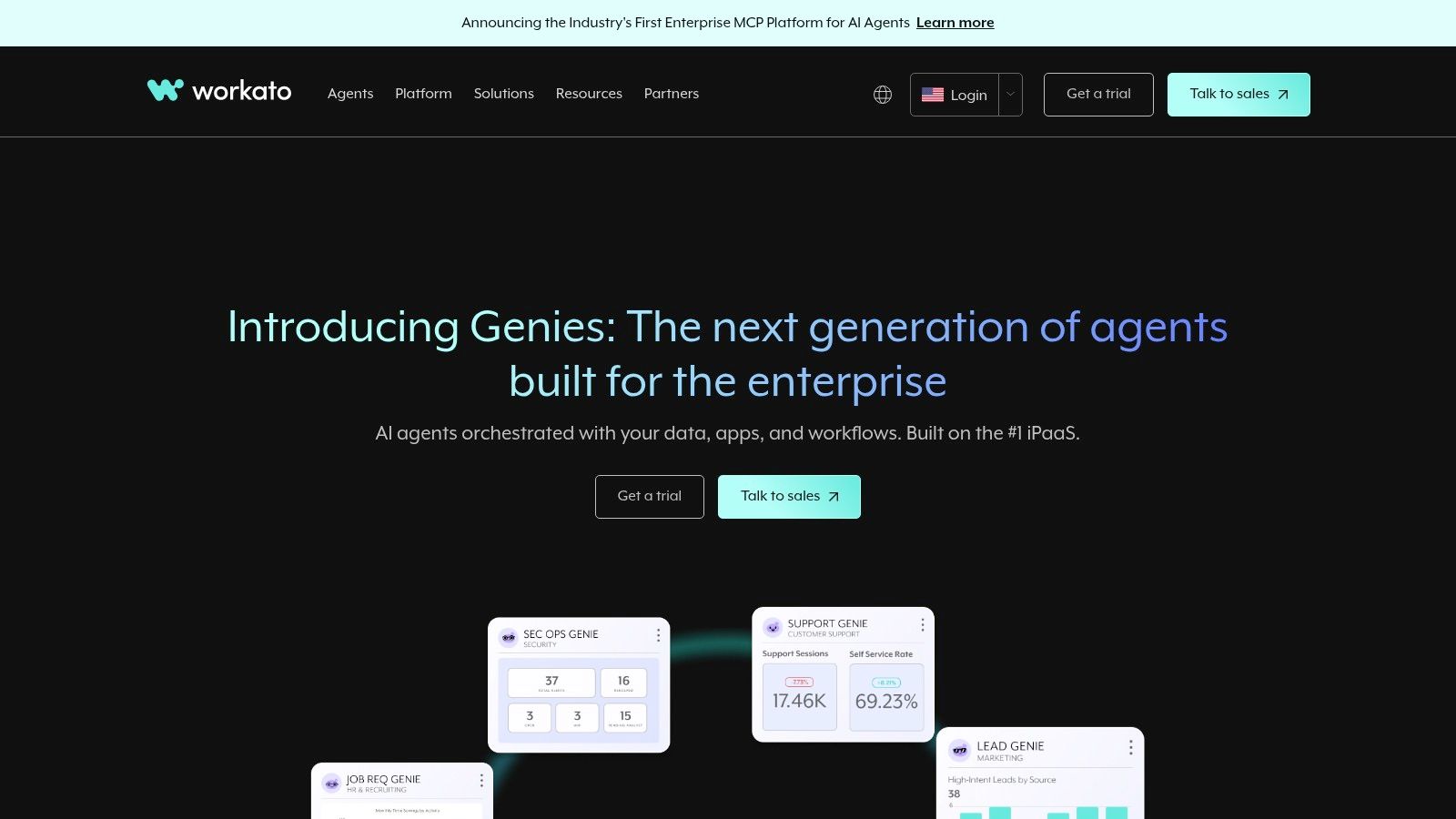
The platform’s strength lies in its comprehensive feature set, including multi-environment operations (dev, test, prod) and detailed monitoring dashboards that provide clear insights into usage and performance. While other no code automation tools focus on simple task-based connections, Workato provides a more holistic solution for embedding automation deep within an organization’s operational fabric, offering features like Workflow Apps to build custom interfaces on top of automations.
Key Details & Use Cases
- Best For: Medium to large enterprises needing a secure, scalable, and governable platform for business-critical automations and embedded integrations.
- Pricing: Pricing is customized and quote-based, tailored to specific business needs. It is generally higher than tools aimed at individuals or small businesses.
- Unique Feature: Its DevOps-like lifecycle management tooling, which allows teams to develop, test, and deploy automations across different environments in a structured way.
- Limitation: The sales-led pricing model and enterprise focus make it less accessible and potentially cost-prohibitive for SMBs or individual users.
Website: https://www.workato.com
8. Tray.io
Tray.io positions itself as an enterprise-grade Integration Platform as a Service (iPaaS) that extends beyond typical no-code automation tools by offering a highly scalable and secure environment. It empowers both business users with a visual workflow builder and technical teams with advanced features like an SDK and API access. The platform is designed to handle complex, high-volume automations, making it a favorite for departmental and company-wide integration strategies.

Its modern interface provides robust control, allowing users to build intricate workflows with branching logic and custom data transformations. A standout capability is the Merlin Agent Builder, which introduces AI agents that can act across multiple systems to complete tasks. This blend of user-friendly automation and powerful, AI-driven functionality helps organizations streamline operations from sales and marketing to HR and finance, ensuring both accessibility and enterprise-level governance.
Key Details & Use Cases
- Best For: Mid-market to enterprise companies needing a scalable, secure, and flexible automation platform for complex, multi-system workflows.
- Pricing: Pricing is not publicly listed and requires contacting their sales team for a custom quote based on usage, features, and support needs.
- Unique Feature: The Merlin Agent Builder provides advanced AI agent tooling that can autonomously execute tasks across connected applications, going beyond standard trigger-and-action automation.
- Limitation: The lack of transparent pricing and the sales-led approach can be a barrier for smaller teams or those wanting to quickly evaluate costs without a formal demo.
Website: https://tray.ai/pricing
9. Pipedream
Pipedream uniquely bridges the gap between no-code and low-code, positioning itself as a powerful workflow platform especially popular with developers and technical teams. It combines a user-friendly, drag-and-drop interface with the ability to write custom code steps in Node.js, Python, or Go. This hybrid approach allows users to handle simple API integrations visually while also tackling complex logic and data transformations that other no code automation tools might struggle with.
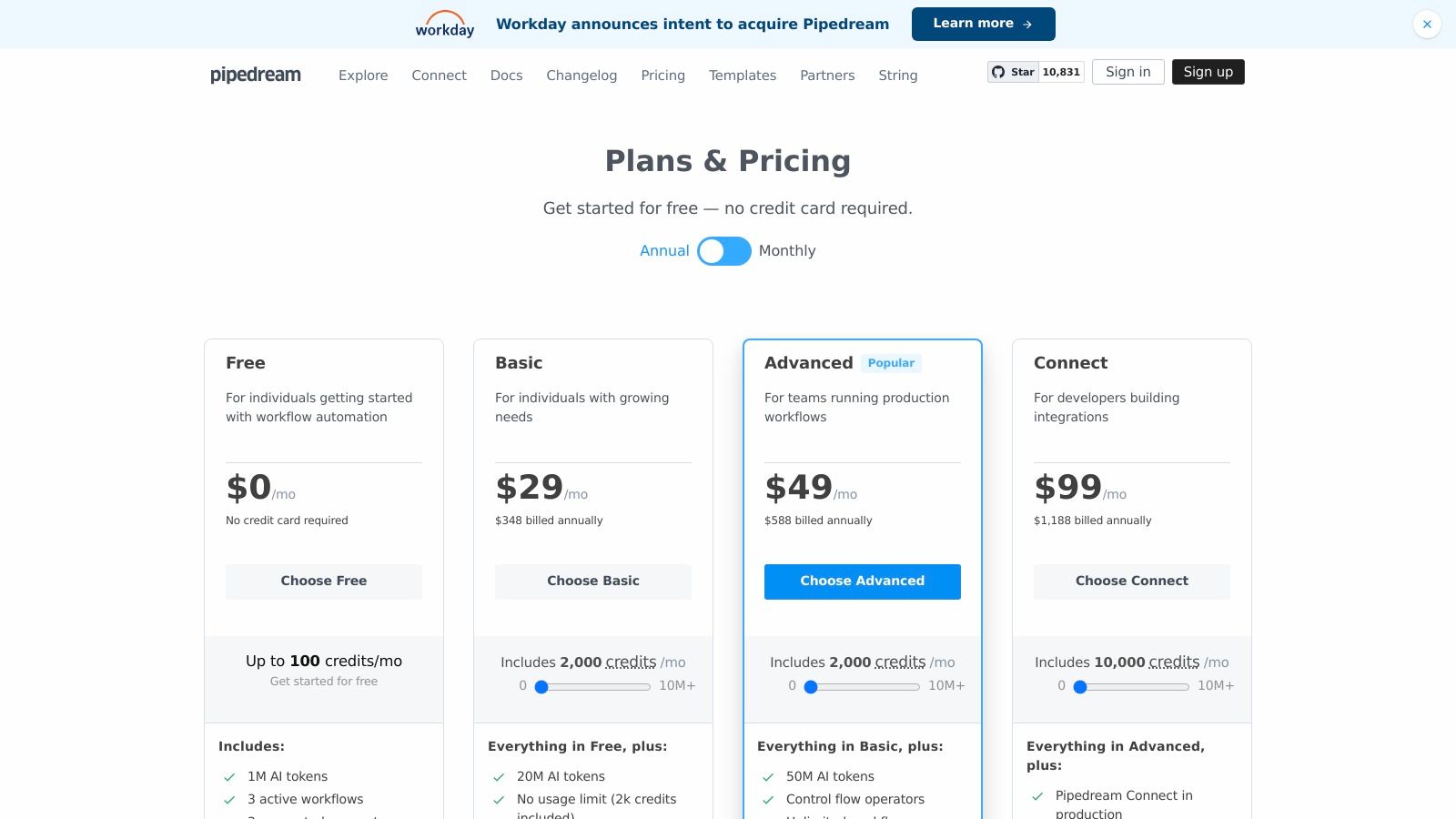
The platform operates on a generous free tier and a transparent, credit-based billing model for compute time, which can be very cost-effective for workflows that run quickly. Features like unlimited workflow testing and native GitHub sync appeal directly to developer ergonomics, making it an excellent choice for teams that want the speed of no-code without sacrificing the power and version control of traditional development. It offers a more technical experience but provides immense flexibility in return.
Key Details & Use Cases
- Best For: Technical users, developers, and teams who need to automate complex API-driven workflows and appreciate the option to inject custom code.
- Pricing: A generous free tier is available. Paid plans are usage-based, starting with a developer plan at $19/month, which includes compute credits and AI tokens.
- Unique Feature: The ability to seamlessly mix pre-built app integrations with custom Node.js, Python, and Go code within the same workflow.
- Limitation: Its interface and concepts like compute credits can present a steeper learning curve for non-technical users compared to purely no-code platforms.
Website: https://pipedream.com/pricing
10. Airtable Automations
Airtable Automations transforms the popular database-spreadsheet hybrid into one of the most powerful no code automation tools for data-centric workflows. Instead of connecting an external service, you can build automations directly within your Airtable bases. This native functionality allows you to trigger actions like sending an email or updating a record whenever data changes, such as when a new record is created or a field is updated to a specific value.
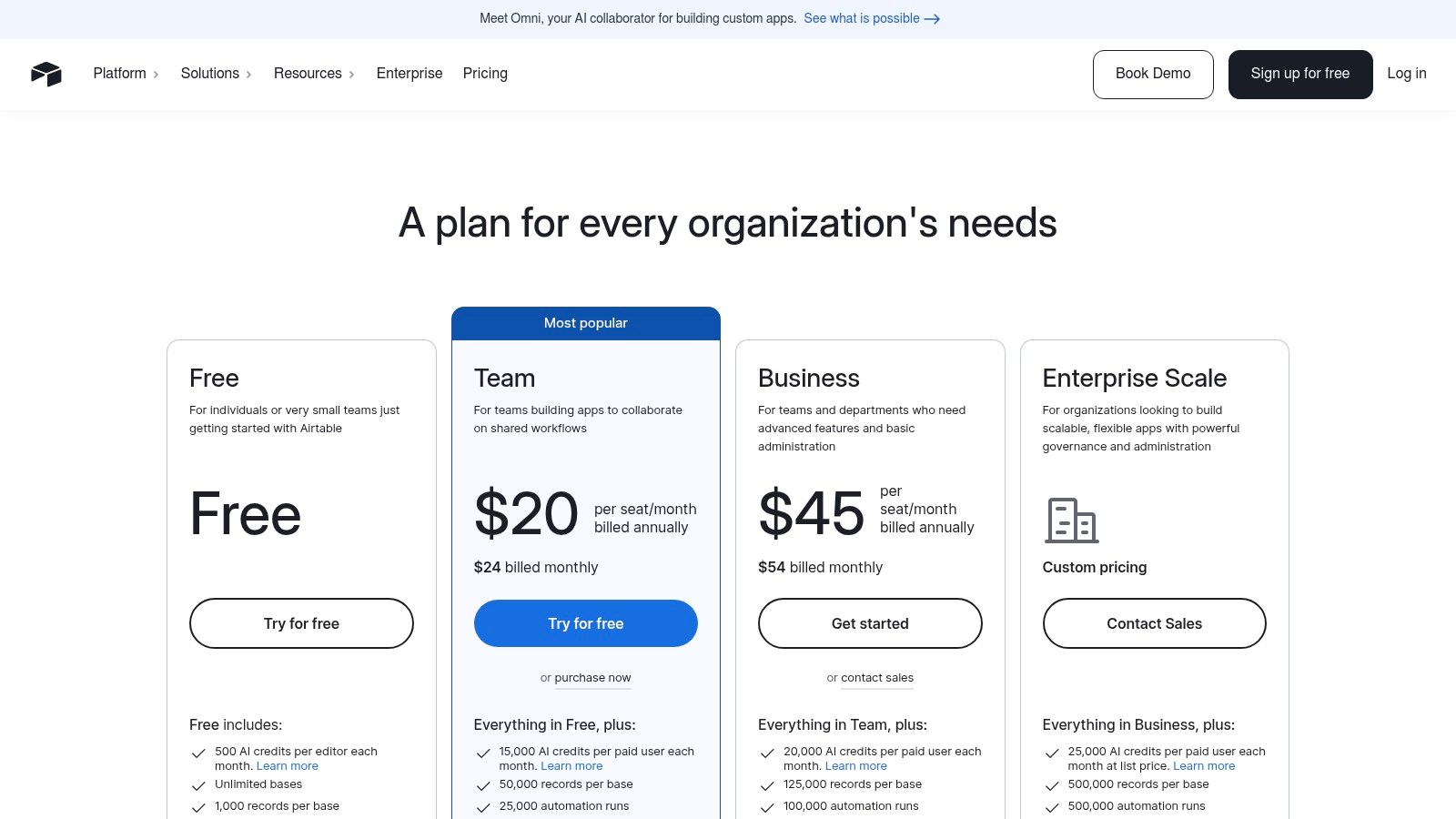
This approach is perfect for teams whose processes already revolve around Airtable, as it eliminates the need for an intermediary tool and keeps everything consolidated. The user interface is clean and intuitive, guiding users to select a trigger (e.g., “When a record enters a view”) and then choose one or more subsequent actions. Its tight integration makes it an efficient solution for managing projects, CRMs, and content calendars without leaving the platform.
Key Details & Use Cases
- Best For: Teams that use Airtable as their central hub for data and want to automate workflows based on that data without relying on third-party tools.
- Pricing: A free plan includes a limited number of automation runs. Paid plans start at $20/user/month (billed annually) and offer higher limits on records, runs, and API calls.
- Unique Feature: The automations are native to your data source, enabling instantaneous and context-aware triggers that are difficult to replicate with external services.
- Limitation: Automation run limits on lower-tier plans can be restrictive for high-volume processes, and scaling often requires upgrading to a Business or Enterprise plan.
Website: https://airtable.com/pricing
11. Parabola
Parabola is a no-code dataflow automation tool specifically designed for operations, ecommerce, and RevOps teams. It excels at managing and transforming data from sources like CSVs and APIs, allowing users to build visual workflows for repetitive data-preparation jobs. Instead of connecting general apps for trigger-based actions, Parabola focuses on creating scheduled, batch-based data syncs and enrichments.
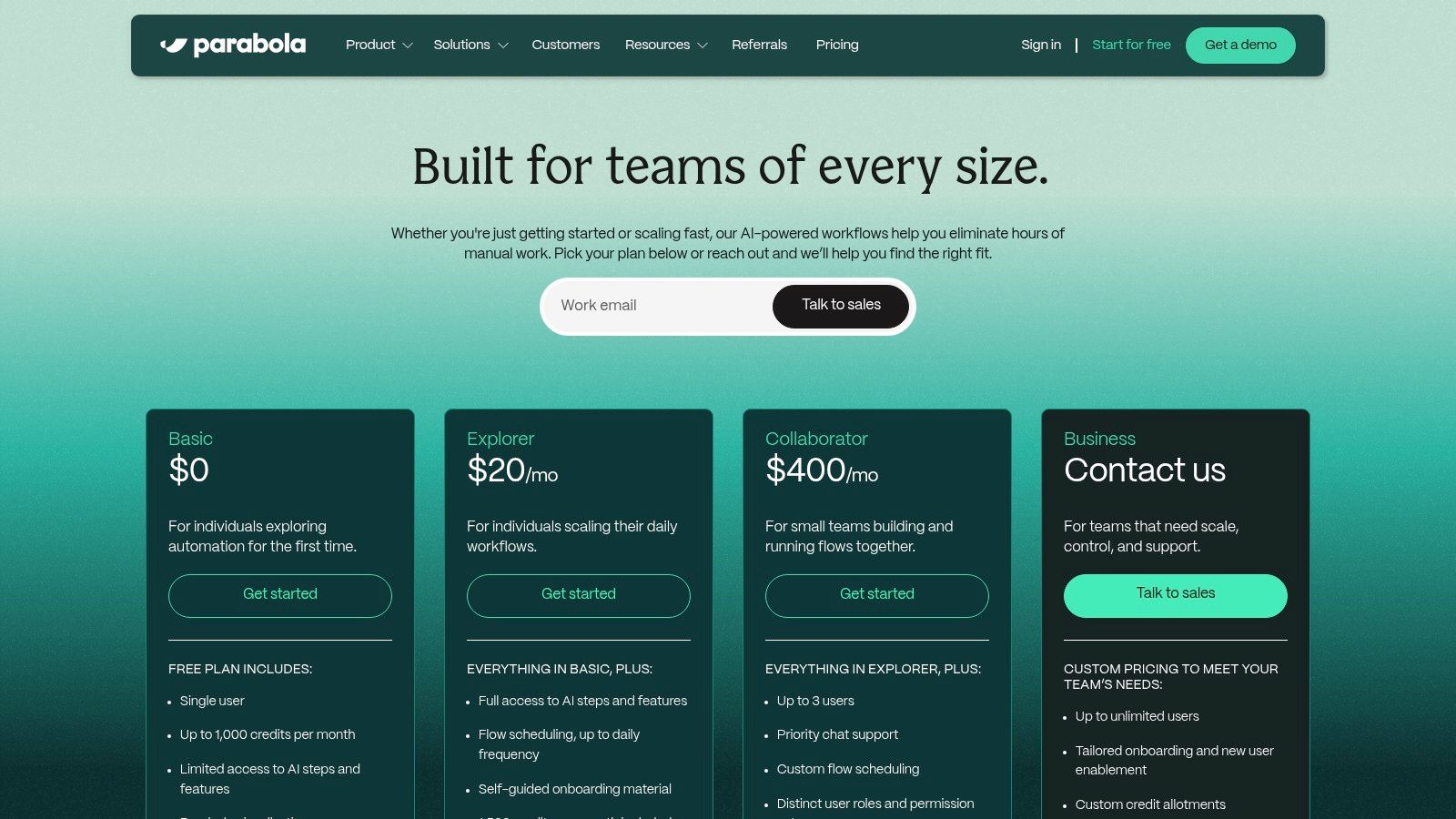
The platform’s strength lies in its drag-and-drop interface where each step in a data flow is a visual block, making complex transformations easy to understand and modify. Users can pull in data, clean it up, merge it with other sources, and then push it to its final destination without writing any code. This approach makes it one of the more powerful no code automation tools for anyone who frequently deals with spreadsheet manipulation or data migration tasks.
Key Details & Use Cases
- Best For: Operations and ecommerce teams that need to automate repetitive data preparation, enrichment, and migration tasks.
- Pricing: Offers a free plan for occasional use. Paid plans start at $20/month and are based on “credits” used to run flows, with unlimited active flows.
- Unique Feature: Its visual, flow-based canvas for data transformations makes complex data manipulation highly accessible and intuitive for non-technical users.
- Limitation: It is not a general-purpose automation tool (iPaaS) and is less suited for real-time, trigger-based workflows between SaaS apps.
Website: https://parabola.io/pricing
12. Google AppSheet
Google AppSheet is a powerful no-code application development platform that inherently includes robust automation capabilities. Rather than just connecting apps, AppSheet allows you to build custom internal tools and mobile applications directly on top of your existing data sources like Google Sheets, Drive, or SQL databases. Its automation features, called “Bots,” enable you to define event-driven workflows within the apps you create, such as sending emails, push notifications, or modifying data based on user actions.
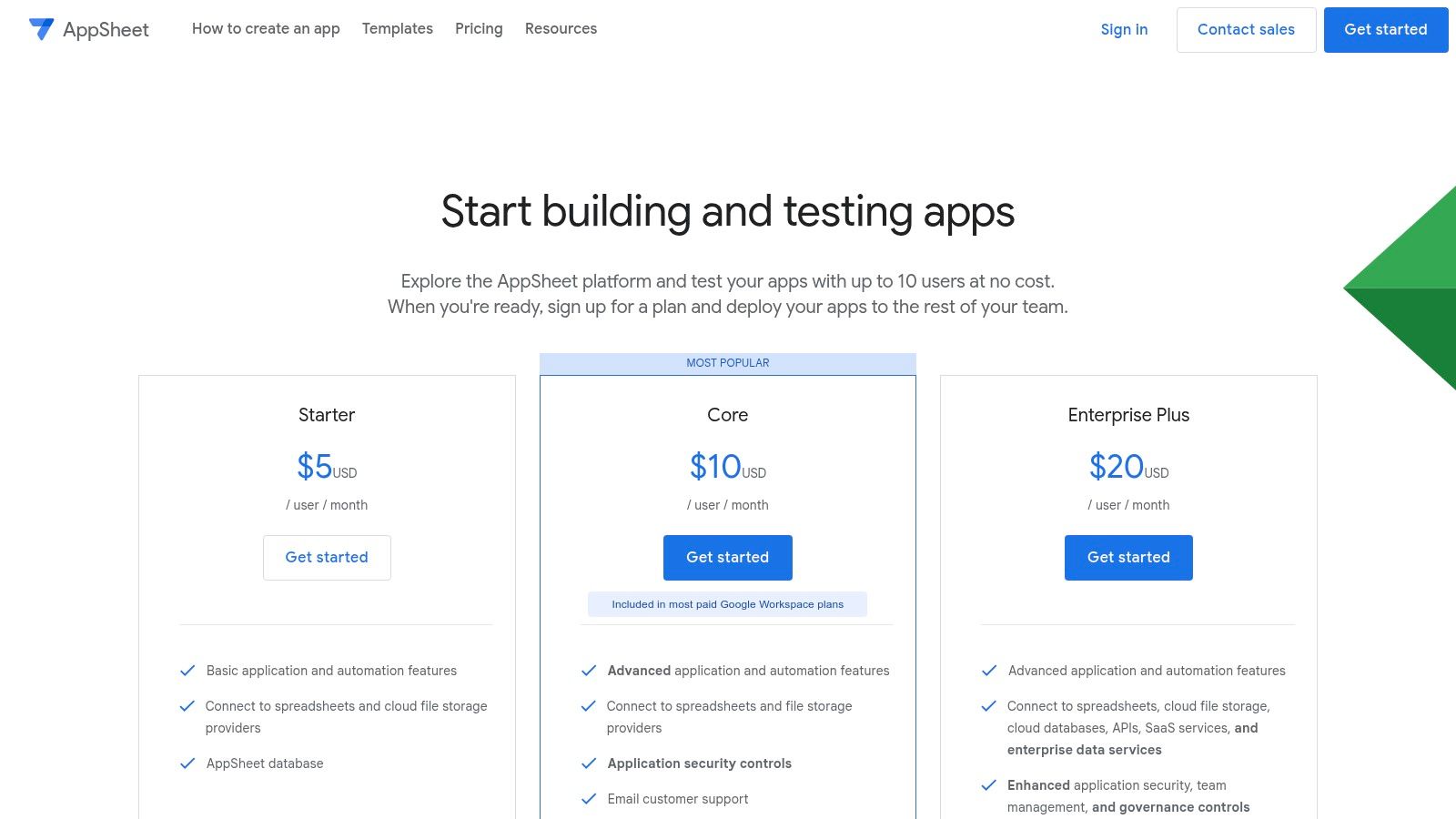
The platform is deeply integrated into the Google Workspace ecosystem, making it a natural choice for organizations already invested in Google’s tools. AppSheet stands out by combining app creation with process automation, empowering teams to build and automate solutions for inventory management, field service reports, or project tracking. This dual capability makes it one of the more versatile no code automation tools for creating holistic internal business systems.
Key Details & Use Cases
- Best For: Teams within the Google Workspace ecosystem that need to build custom internal applications with built-in data-driven automations.
- Pricing: Offers a free plan for prototyping with up to 10 users. Paid plans start at $5/user/month (Core plan) and scale with more advanced features and governance.
- Unique Feature: The ability to create a fully functional, data-centric mobile or web application and embed complex automations directly within it, all from a single platform.
- Limitation: The user interface can have a steeper learning curve compared to more linear automation tools, and public-facing app deployment requires a separate, more expensive Publisher Pro plan.
Website: https://about.appsheet.com/pricing
Top 12 No‑Code Automation Tools — Side-by-Side Comparison
| Product | Core features | UX & quality (★) | Price & value (💰) | Target audience (👥) | Unique selling point (✨) |
|---|---|---|---|---|---|
| Sagekit 🏆 | NL prompts → multi-step workflows; live visual canvas; connectors (Gmail, Sheets, Slack); instant & scheduled runs | 5★ — 2‑min setup, templates, 1k+ users | 💰 Free (200 runs/mo) → Pro $19/mo → Growth $69/mo → Enterprise | 👥 Non-technical teams & power users | ✨ NL→automation + AI extraction + web scraping |
| Zapier | 6,000+ apps; multi-step Zaps, Paths, Filters | 4★ — broad ecosystem, easy setup | 💰 Free → paid per task; costs scale with volume | 👥 SMBs, non-technical users | ✨ Largest app ecosystem; widely familiar |
| Make (Integromat) | Drag‑drop canvas; routers/filters; scheduling; 2,000+ apps | 4★ — good for complex flows | 💰 Credit-based; cost-effective for high volume | 👥 Ops teams & advanced no-code users | ✨ Granular control + lower per-action cost |
| n8n | Open-source nodes; unlimited steps; self‑host or cloud | 4★ — extensible; self-host needs DevOps | 💰 Self-host free; Cloud paid by executions | 👥 Dev teams & privacy-focused orgs | ✨ Self-hosting + unlimited complexity |
| IFTTT | Applets for 900+ services; mobile-first | 3★ — easiest on-ramp | 💰 Free → Pro+ (multi-action, queries) | 👥 Consumers, simple personal automations | ✨ Very simple, strong IoT/mobile focus |
| Microsoft Power Automate | Cloud flows + RPA (desktop flows); M365 & Azure integration | 4★ — enterprise-grade, strong governance | 💰 Per-user or per-bot licensing; enterprise add-ons | 👥 Microsoft-centric enterprises | ✨ Deep M365/Azure integration & compliance |
| Workato | Enterprise iPaaS; Workflow Apps; multi-environment tooling | 4★ — robust for enterprise integrations | 💰 Sales-led, usage-based (premium) | 👥 Enterprise IT & integration teams | ✨ Rich governance, lifecycle & analytics |
| Tray.io | 600+ connectors; UI builder; RBAC & SDK | 4★ — enterprise-ready; sales-led onboarding | 💰 Sales-led pricing (contact sales) | 👥 Enterprise product & integration teams | ✨ AI agent tooling + embedded integrations |
| Pipedream | Low-code with Node/Python/Go steps; compute credit model | 4★ — developer-first, generous free tier | 💰 Free tier + credit-based compute & AI tokens | 👥 Developers & API/platform teams | ✨ Code steps + GitHub sync + transparent compute billing |
| Airtable Automations | Triggers/actions inside Airtable; AI credits; admin features | 3★ — seamless if data already in Airtable | 💰 Included in Airtable plans; run limits apply | 👥 Teams using Airtable as primary data store | ✨ Native data+automation in one tool |
| Parabola | Visual dataflows for CSV/API transforms; scheduling | 3★ — strong for repetitive data prep | 💰 Credits-based runs; focused pricing | 👥 Ecommerce, RevOps & data ops teams | ✨ No-code ETL & enrichment for ops workflows |
| Google AppSheet | No-code app builder + Bots; Google Workspace connectors | 3★ — tight Google integration; prototype friendly | 💰 Per-user pricing; free prototype up to 10 users | 👥 Internal apps for Google Workspace users | ✨ Rapid internal apps with built-in automations |
Final Thoughts
The landscape of no code automation tools is more vibrant and accessible than ever before. As we’ve explored, the journey from manual, repetitive work to streamlined, automated efficiency is no longer reserved for those with deep technical expertise. Platforms like Zapier and Make have set the standard for broad application support, while specialists like Airtable Automations and Parabola demonstrate the power of integrating automation directly within data-centric environments.
The core takeaway is this: the “best” tool is entirely subjective and depends on your unique context. A solopreneur’s needs differ vastly from those of a large enterprise operations team. Your ideal solution hinges on a clear understanding of your specific workflows, the applications you rely on daily, and your budget constraints. The right choice is the one that seamlessly integrates into your existing processes, requires minimal maintenance, and delivers a tangible return on investment, whether measured in time saved or errors eliminated.
Your Next Steps in Automation
Before committing to a platform, it’s crucial to map out your own requirements. Take a moment to perform a simple “workflow audit” to identify the most impactful automation opportunities.
- Identify Repetitive Tasks: What actions do you or your team perform daily or weekly that are time-consuming and rule-based? This could be anything from copying data between a form and a spreadsheet to sending standardized follow-up emails.
- List Your Core Applications: What software is indispensable to your operations? Your CRM, email marketing platform, project management tool, and cloud storage are all key parts of your potential automation ecosystem. Ensure your chosen tool has robust integrations for these critical apps.
- Assess Complexity and Scale: Are you linking two simple apps, or do you need to build a multi-step workflow with conditional logic, data transformation, and error handling? Your answer will guide you toward either a simple connector like IFTTT or a more powerful visual workflow builder like Make or Sagekit.
- Consider Your Budget and Future Growth: Start with free tiers or trials to validate a tool’s effectiveness for a specific use case. However, keep an eye on the pricing models. A task-based model might be cost-effective now but could become expensive as your automation usage scales.
Embracing the No-Code Revolution
Ultimately, the power of no code automation tools lies in their ability to democratize problem-solving. They empower you, the person who best understands the business process, to build the solution directly. This shift moves automation from a specialized IT function to a core business competency accessible to everyone. By thoughtfully selecting and implementing the right tool, you can reclaim countless hours, reduce operational friction, and unlock new levels of productivity for yourself and your team.
Ready to move from theory to practice with a tool designed for clarity and power? Sagekit simplifies the creation of sophisticated, multi-step workflows with an intuitive visual canvas, making it one of the most user-friendly no code automation tools for professionals and teams. Start automating your most critical business processes in minutes by exploring Sagekit today.